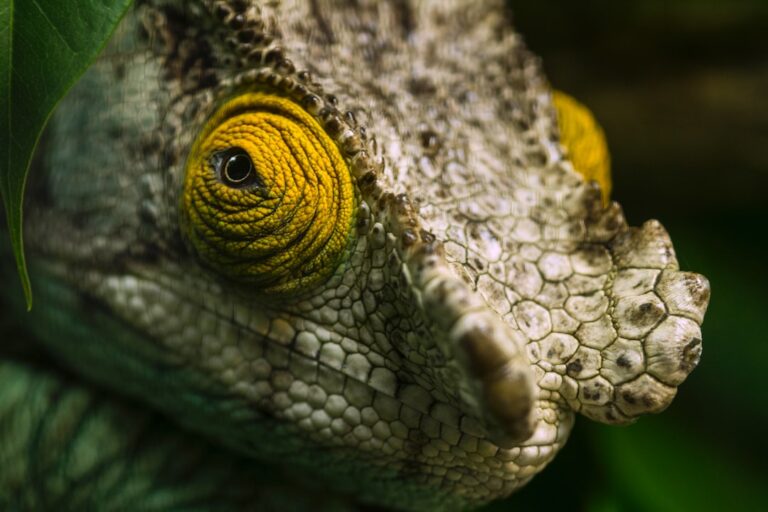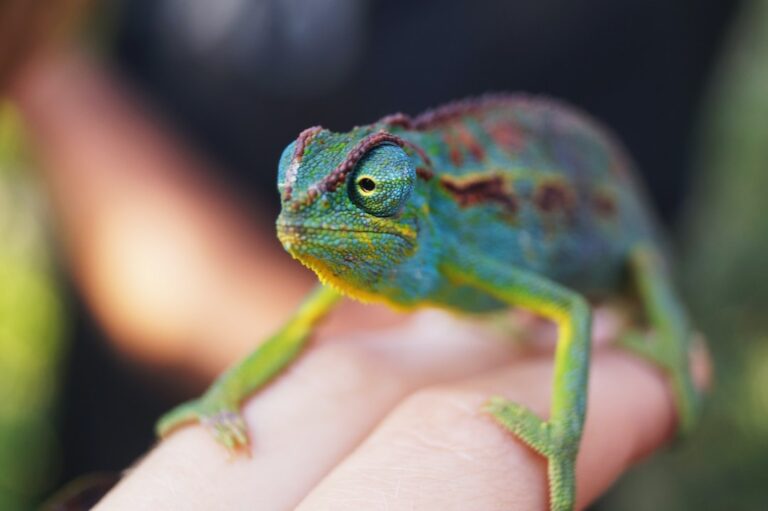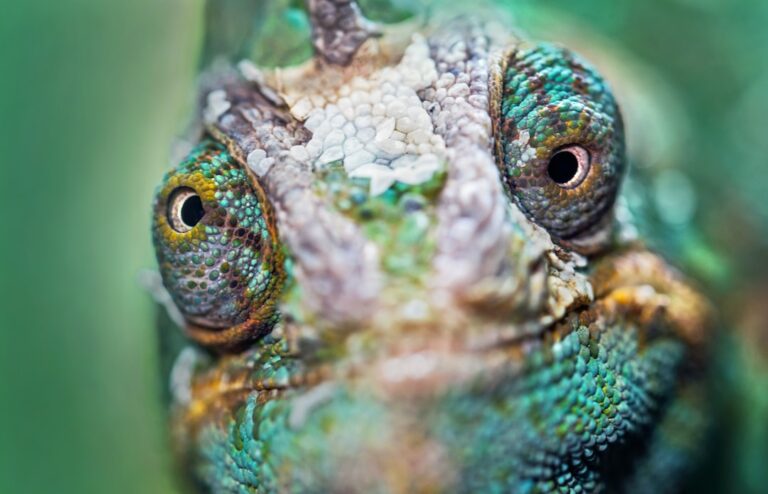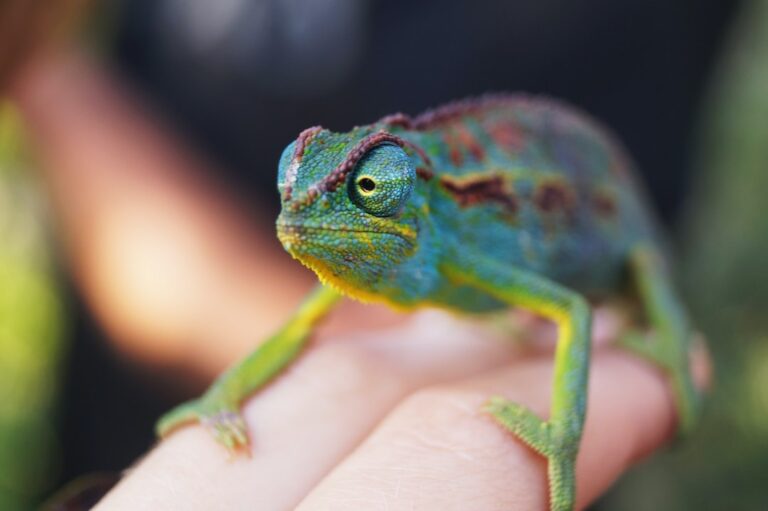Where Do Chameleons Like To Hide?
Chameleons are fascinating creatures known for their unique ability to change color. They belong to the family Chamaeleonidae and are found in various parts of the world, including Africa, Madagascar, and parts of Asia and Europe. Chameleons are known for their distinctive physical characteristics, such as their long tongues, independently moving eyes, and prehensile tails.
One of the most remarkable features of chameleons is their ability to change color. They can change their skin color to blend in with their surroundings or to communicate with other chameleons. This color-changing ability is due to specialized cells called chromatophores in their skin. These cells contain pigments that can expand or contract, allowing the chameleon to change its color.
Table of Contents
The Natural Habitat of Chameleons
Chameleons are typically found in a variety of environments, including rainforests, deserts, and savannas. The specific habitat of a chameleon depends on its species. For example, some species prefer dense vegetation, while others thrive in arid regions.
The natural habitat of a chameleon plays a significant role in its behavior. In rainforest environments, chameleons can be found climbing trees and using their prehensile tails to hold onto branches. In desert environments, they may spend more time on the ground or hiding in rock crevices to escape the heat.
The temperature and humidity levels in their habitat also affect their behavior. Chameleons are ectothermic animals, which means they rely on external sources of heat to regulate their body temperature. In cooler environments, they may bask in the sun to warm up, while in hotter environments, they may seek shade or burrow into the ground to cool down.
Why Do Chameleons Hide?
Chameleons have evolved to be masters of camouflage and hiding. There are several reasons why chameleons hide, including protection from predators and regulating body temperature.
One of the primary reasons chameleons hide is to protect themselves from predators. Their ability to change color allows them to blend in with their surroundings, making it difficult for predators to spot them. By hiding in foliage or using their color-changing abilities, chameleons can avoid being detected by predators such as birds and snakes.
Another reason chameleons hide is to regulate their body temperature. As ectothermic animals, chameleons rely on external sources of heat to warm up their bodies. By hiding in shaded areas or burrowing into the ground, they can escape the heat and maintain a comfortable body temperature.
Types of Hiding Spots for Chameleons
Chameleons have a variety of hiding spots in their natural habitat. These hiding spots provide them with protection and allow them to blend in with their surroundings.
One common type of hiding spot for chameleons is tree bark. Chameleons have specialized feet that allow them to grip onto tree branches and bark. They can hide in the crevices of tree bark, using their color-changing abilities to blend in with the texture and color of the bark.
Leaves are another common hiding spot for chameleons. They can hide among the leaves of plants and trees, using their ability to change color to match the color of the leaves. This allows them to remain hidden from predators and potential prey.
The Importance of Hiding for Chameleons
Hiding is crucial for the survival of chameleons in their natural habitat. It allows them to avoid predators and regulate their body temperature, ensuring their overall well-being.
By hiding in foliage or using their color-changing abilities, chameleons can effectively camouflage themselves and avoid being detected by predators. This increases their chances of survival and allows them to focus on other essential activities, such as finding food and mating.
Providing hiding spots for pet chameleons is also essential. In captivity, chameleons may experience stress if they do not have adequate hiding spots. Hiding spots provide them with a sense of security and allow them to retreat when they feel threatened or overwhelmed.
How Do Chameleons Choose Their Hiding Spots?
Several factors influence where chameleons choose to hide in their natural habitat. These factors include the availability of hiding spots, the temperature and humidity levels, and the presence of predators or potential prey.
Chameleons are highly adaptable creatures and can choose hiding spots that best suit their needs. They may select hiding spots that provide shade and protection from predators, such as dense foliage or tree bark. They may also choose hiding spots that allow them to bask in the sun or burrow into the ground to regulate their body temperature.
Chameleons also use their color-changing abilities to blend in with their surroundings. They can change their skin color to match the color of the leaves or bark, making it difficult for predators or prey to spot them.
Common Hiding Spots for Chameleons in the Wild
In their natural habitat, chameleons have a variety of common hiding spots. These hiding spots allow them to effectively camouflage themselves and remain hidden from predators or potential prey.
One common hiding spot for chameleons is among the leaves of plants and trees. They can hide among the foliage, using their color-changing abilities to match the color of the leaves. This allows them to blend in with their surroundings and avoid detection.
Another common hiding spot for chameleons is tree bark. Chameleons have specialized feet that allow them to grip onto tree branches and bark. They can hide in the crevices of tree bark, using their color-changing abilities to blend in with the texture and color of the bark.
Creating Hiding Spots for Pet Chameleons
Providing hiding spots for pet chameleons is essential for their well-being. In captivity, chameleons may experience stress if they do not have adequate hiding spots. Here are some tips for creating hiding spots for pet chameleons:
1. Provide a variety of hiding spots: Chameleons may have different preferences when it comes to hiding spots. Some may prefer dense foliage, while others may prefer tree bark or branches. It is essential to provide a variety of hiding spots to cater to their individual needs.
2. Use live plants: Live plants not only provide hiding spots for chameleons but also help maintain humidity levels in their enclosure. Choose plants that are safe for chameleons and can withstand the conditions in their enclosure.
3. Create vertical space: Chameleons are arboreal creatures and prefer to climb and hide in elevated areas. Provide branches or vines that allow them to move around and hide at different heights in their enclosure.
4. Avoid overcrowding: While it is important to provide multiple hiding spots, it is also crucial not to overcrowd the enclosure. Chameleons need space to move around and explore their environment.
Challenges of Finding Chameleons in Their Hiding Spots
Studying chameleons in the wild can be challenging due to their hiding habits. Chameleons are masters of camouflage and can blend in with their surroundings, making them difficult to find.
Researchers often face difficulties locating chameleons in their natural habitat due to their ability to change color and hide among foliage or tree bark. This makes it challenging to conduct population surveys or study their behavior.
Additionally, chameleons are often found in remote or inaccessible areas, making it difficult for researchers to reach them. This further adds to the challenges of studying chameleons in the wild.
Understanding the Hiding Habits of Chameleons
In conclusion, hiding is an essential behavior for chameleons. It allows them to protect themselves from predators, regulate their body temperature, and ensure their overall well-being.
Understanding the hiding habits of chameleons is crucial for their survival and well-being. By providing adequate hiding spots for pet chameleons in captivity, we can help reduce their stress levels and provide them with a sense of security.
Studying chameleons in their natural habitat can be challenging due to their hiding habits. However, by understanding their behavior and the factors that influence their choice of hiding spots, researchers can gain valuable insights into these fascinating creatures.
If you’re curious about the sleeping habits of chameleons, you might also be interested in learning whether chameleons can sleep upside down. According to a fascinating article on Reptile Friend, chameleons have the ability to sleep in various positions, including hanging upside down from branches. This unique behavior allows them to blend in with their surroundings and stay hidden from predators. To find out more about this intriguing aspect of chameleon behavior, check out the article “Can Chameleons Sleep Upside Down?”







